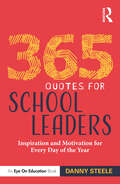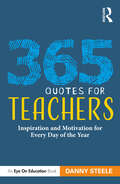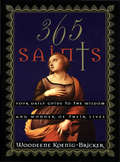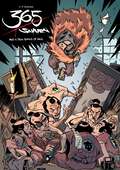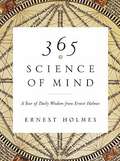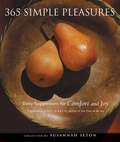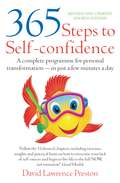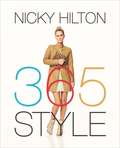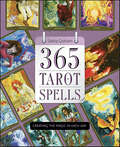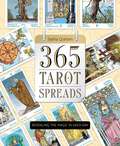- Table View
- List View
365 Prayers for the Family
by Diane LawIn times of trial, we raise our voices to pray for support.; in times of joy, we long to find the words to give thanks. Gatherered here are prayers for every occasion, simple enough for the innocent child and profound enough to touch the maturest heart.
365 Prescriptions for the Soul: Daily Messages of Inspiration, Hope, and Love
by Dr. Bernie S. SiegelDr. Bernie Siegel writes with humorous, down-to-earth wisdom that has improved the lives of countless readers. In 365 Prescriptions for the Soul, he treats us to his most user-friendly work of all: daily doses of inspiration and humor that gently and joyfully help us live more peaceful, loving, and fulfilling lives.
365 Questions For Couples
by Michael J BeckWhat does he really think?How many things would you like to know-but don't-about your partner? Do you wish your partner would ask you about your past, your goals, your inner thoughts? When was the last time the two of you shared a dream, a memory, or a fantasy together?365 Questions for Couples shows you how to get closer to your partner by asking and answering thought-provoking questions on such subjects as:Your relationshipRelationship with othersGoals and fantasiesLife experiencesMemoriesSex Remember, there are no right or wrong answers. The only rule is that you cannot ask a question that you refuse to answer yourself. So put some quiet time aside, make yourself comfortable, and enter together into the world of goals, dreams, emotions, and your previously hidden past!
365 Questions For Couples
by Stanis Marusak Beck Michael J. BeckHow many things would you like to know--but don't--about you partner? Do you wish your partner would ask about your past, your goals, your inner thoughts? When was the last time the two of you shared a dream, a memory, or a fantasy together? 365 Questions For Couples shows you how to get closer to your partner by asking and answering thought-provoking questions on various subjects. Remember, there are no right or wrong answers. The only rule is that you cannot ask a question that you refuse to answer yourself. So put some quiet time aside, make yourself comfortable and enter together into a world of goals, dreams, emotions, and your previously hidden past!
365 Questions for Couples
by Stanis Marusak Beck Seanna Beck Michael J. BeckAsks the intimate & fun questions you've always been curious about.
365 Quick & Easy Tips: Simple Techniques to Keep Your Home Neat and Tidy Year Round
by Weldon OwenSay goodbye to the clutter with 365 Quick & Easy Tips: Home Organization. It&’s time to tackle your mess and take back every square foot of your home by applying just one, easy organization step a day in each of the 21 most common home spaces, including kitchens, offices, living rooms, guest areas, baby and kids&’ rooms, entryways, hallways, utility spaces, garages, closets, and pet areas. Whether you live in a tiny urban apartment or a sprawling suburban home, this book will help you fall back in love with your space. 365 Quick & Easy Tips: Home Organization walks you through all you need to store your belongings, save space, and get rid of things you no longer need. Learn to organize your pantry, keep seasonal items in designated places, and properly display keepsakes. 365 TIPS: Discover a practical, easy-to-do organizing tip for every day of the year! TWENTY-ONE ZONES: Tackle clutter by establishing 21 distinct zones in your home, such as the pantry, basement, kitchen, kids&’ room, and bathroom. INSPIRING IMAGES: Filled with stunning and aspirational images of organized spaces that anyone can achieve. CLEAR STEP-BY-STEP INSTRUCTIONS: Checklists, detailed illustrations, and expert tips help you become and stay organized. COMPLETE YOUR SERIES COLLECTION: Take your home organization to the next level with The Complete Book of Clean and The Complete Book of Home Organizing.
365 Quick & Easy Tips: Simple Techniques to Keep Your Home Spotless and Polished Year Round
by Weldon OwenQuick and Easy Home Cleaning gives you everything you need to know on how to establish practical cleaning routines, create daily upkeep schedules, and make DIY green-cleaning solutions to help keep every area of your home neat, safe, and, most importantly, spotless. Learn how to tackle the most difficult stains, how often to deep clean upholstery, and how to maintain cleanliness throughout all 365 days of the year. Complete with step-by-step instructions and handy checklists to make cleaning and organizing your home easier than you ever thought possible, learn the secrets to implementing a proven cleaning system to keep up with daily, weekly, and monthly chores for a spotless home. Whether you&’re new to home keeping or a seasoned cleaner, you&’ll find that cleanliness is achievable all year long, one day at a time. 365 TIPS: Discover a practical, easy-to-do cleaning tip for every day of the year SIMPLE STEPS: Quick and Easy Home Cleaning breaks down the seemingly daunting task of cleaning your home into simple steps that anyone can do MAKE DIY CLEANING PRODUCTS: Learn how to make your own economical and environmentally friendly cleaning solutions that make your house sparkle while also being kind to the Earth
365 Quotes for School Leaders: Inspiration and Motivation for Every Day of the Year
by Danny SteeleStart your morning with a daily dose of inspiration! Bestselling author Danny Steele, known for his motivational @steelethoughts tweets, brings you a powerful quote for every day of the year. You’ll find quotes on topics such as school culture, supporting your staff, effective leadership, positive communication, and more. Read them to kick off your morning, to wind down at night, or whenever you need to recharge. Share them at staff meetings and workshops to set the tone or spark conversation. The uplifting, insightful quotes will remind you of the positive impact you’re having on your school, each and every day.
365 Quotes for Teachers: Inspiration and Motivation for Every Day of the Year
by Danny SteeleStart your morning with a daily dose of inspiration! Bestselling author Danny Steele, known for his motivational @steelethoughts tweets, brings you a powerful quote for every day of the year. You’ll find quotes on topics such as reaching your students, working with colleagues, taking care of yourself, remembering your purpose, and more. Read them to kick off your morning, to wind down at night, or whenever you need to recharge. The uplifting, insightful quotes will remind you of the positive impact you’re having on your students, each and every day.
365 Saints: Your Daily Guide to the Wisdom and Wonder of Their Lives
by Woodeene Koenig-BrickerLet the saints’ lives guide and touch your life each day, with a full year of meditations, quotations, and inspiring suggestions.The life of a saint is the life of an ordinary person lived well. And that’s the life readers will discover in this delightful and often surprising collection of words and wisdom from saints throughout the ages.365 Saints illuminates how the saints actually lived, detailing their hopes, fears, joys, and sorrows, as well as their lesser–known idiosyncrasies and sayings. Witty and wondrous, simple and sublime, 365 Saints offers a full year of meditations and practical suggestions for emulating the saints today.
365 Samurai and a Few Bowls of Rice
by J.P. KalonjiJ. P. Kalonji wields a clean, street-informed style to deliver a tale that glistens with blood and drama, yet is ultimately uplifting. Nearly four hundred pages long, this graphic novel employs full-page panels to tell the story of an Edo-era swordsman's quest for survival and enlightenment. When Ningen leaves his dojo at the request of his master — to travel the world and grow as a swordsman — he embarks on a journey that becomes a metaphor for the cycle of life and every human's possibility for spiritual growth.* Collaborating with such international clients as Wyclef Jean, Amnesty International, Thrasher, and Burton snowboards, illustrator J. P. Kalonji has begun to enchant the world with his energetic art style. Now he's ready to make a splash with his English-language graphic-novel debut!* This engaging, nearly 400-page tale draws comparisons to both Hiroaki Samura's Blade of the Immortal and Jeff Smith's Bone.
365 Science of Mind (pb reissue)
by Ernest HolmesThis newly repackaged edition of one of Tarcher's bestselling Holmes backlist titles contains wisdom designed to help each reader experience the Science of Mind philosophy day by day.
365 Simple Pleasures: Daily Suggestions for Comfort and Joy
by Susannah Seton365 Days of Self-Care StrategiesAim to be the best version of yourself year round with daily arts and crafts, recipes, and pampering ideas.Seasonal self-care. 365 Simple Pleasures makes it easier than ever to take care of yourself throughout the year. As the seasons change, so do these self-care ideas. Whether installing a low maintenance cactus garden in the summer or crafting scented candles for the holidays, these self-care activities take good care of the mind, body, and soul.Self-care made easy. Along with easy, daily activities, author Susannah Seton explains why we enjoy each of these simple pleasures and why simple joys really do go a long way. Inside, find self-care tips and learn how to:Release stress with lavender and rosemary craftsPamper yourself with a DIY spa dayBake comfort foods like bread and maple candyIf you enjoyed books like The More or Less Definitive Guide to Self-Care, The Self Care Prescription, or The Spirit Almanac, you’ll love 365 Simple Pleasures.
365 Skinny Smoothies
by Daniella ChaceA smoothie a day keeps the fat away. So go on. Blend your way to skinny. Forget those 700-calorie "healthy" smoothies you've been drinking. Daniella Chace, nutritionist and bestselling author of Smoothies for Life!, has whipped up 365 recipes that will kick-start your weight loss with daily doses of delicious, medicinally potent superfood smoothies. Organized by season and month, each of these 365 smoothie recipes is a satisfying blend of whole foods that are rich in nutrients that help you shed body fat. Powerhouse ingredients-such as pomegranate juice, chia seeds, green tea and cocoa powder-will boost your metabolism, increase fat-fighting enzymes and even curb your appetite And with names like Tulsi Avocado Cream, Green Lushy, Svelte Synergy and The Violet TuTu, you'll be sipping your way to increased muscle and reduced fat while your taste buds-and waistline-rejoice.
365 Skinny Smoothies: Healthy, Never-boring Recipes And 52 Weekly Shopping Lists For Stress-free Weight Loss
by Daniella Chace MSc, CNNever-repeating recipes and an easy-to-implement plan make daily smoothies a fast and healthy habit. Leading nutritionist Daniella Chace takes the guesswork out of what to blend with 365 recipes—yes, one for each day of the year—organized with the busy person in mind. Grouped in weekly installments by season with corresponding shopping lists, this book will appeal to readers who want to lose weight, increase energy, reduce bloat, and feel great, but need a straightforward, step-by-step plan to put them on track. Less thinking about the ingredients, more enjoying the result. Each recipe introduces a weight-loss concept, such as adding probiotic supplements and cultured foods; increasing phytochemicals found in greens and berries; boosting spices that reduce inflammation; hydrating with electrolytes; stocking up on frozen berries and dry goods; and adding protein such as hemp, chia, or protein supplement powders to increase satiation. Fans of the program keep on drinking Chase’s smoothies year after year!
365 Slow Cooker Suppers
by Stephanie O'DeaA dinner for every night of the year—including gluten-free versions—from the New York Times bestselling author of Make It Fast, Cook It Slow. Because they are easy to use and allow home cooks to buy affordable cuts of meat that become fall-off-the-bone tender, slow cookers have become one of the most popular kitchen appliances. The challenge is finding well-tested recipes, and that&’s where bestselling author Stephanie O&’Dea comes in. With her wildly popular website (crockpot365.blogspot.com) that attracts more than a million visitors a month and appearances on numerous national morning shows, including Good Morning America, O&’Dea has become a go-to resource for busy home cooks. In 365 Slow Cooker Suppers, fans have a year&’s worth of options for easy and taste-tempting dinners—from Nantucket Scallop Chowder to Pulled Pork Sandwiches, Chicken Caesar Salad to Bacon Risotto. A section on meatless main dishes, gluten-free options for every recipe, and full-color photography make this a must-have collection for slow cooker enthusiasts. &“The book is beautiful. There are pictures of the delicious meals throughout the book, that literally make your mouth water.&”—Mom&’s Bistro
365 Steps to Self-Confidence 4th Edition: A Complete Programme For Personal Transformation (How To Bks.)
by David Lawrence PrestonConfidence is crucial to a happy and fulfilling life. And yet many of us lack confidence and self-belief. As a result, we are less adventurous and less likely to get the most out of life. This book is a carefully structured, daily programme covering the following areas: * Deciding to be confident * Harnessing self-awareness * How to think confidently * Using your imagination to improve your self-image * How to act with confidence * Communicating with confidence Each of the 52 sections contains information, insights and words of inspiration, plus seven exercises and practical hints or points to ponder. Fifteen minutes a day will give you tools and techniques which have worked for millions of people around the world. If you read the material carefully and apply what you learn, you really will notice big changes taking place within two or three months. A year from now you'll be amazed at how much more confident you've become.
365 Steps to Self-Confidence 4th Edition: A Complete Programme for Personal Transformation - in Just a Few Minutes a Day
by David Lawrence PrestonConfidence is crucial to a happy and fulfilling life. And yet many of us lack confidence and self-belief. As a result, we are less adventurous and less likely to get the most out of life. This book is a carefully structured, daily programme covering the following areas: * Deciding to be confident * Harnessing self-awareness * How to think confidently * Using your imagination to improve your self-image * How to act with confidence * Communicating with confidence Each of the 52 sections contains information, insights and words of inspiration, plus seven exercises and practical hints or points to ponder. Fifteen minutes a day will give you tools and techniques which have worked for millions of people around the world. If you read the material carefully and apply what you learn, you really will notice big changes taking place within two or three months. A year from now you'll be amazed at how much more confident you've become.
365 Student Cookbook
by Jo McAuley All Colour Cookery Library.With its quick, easy, healthy and budget-friendly recipes, The Student 365 Cookbook is the ideal cookbook to keep hungry, time-pressed students going throughout the academic year. This fantastic selection includes new twists and international flavours, such as Potato, cauliflower and spinach curry, Jalapeno turkey burgers and Teriyaki salmon noodles, as well as old favourites to re-create the flavours of home, like Creamy fish pie and Spaghetti and meatballs. If you're craving something sweet, why not whip up some Apricot and almond tartlets or Lemon popping candy cakes?With variations on each recipe you will find endless inspiration, for both feeding your friends and speedy on-the-go meals for one - perfect for for keeping those microwave meals at bay.
365 Student Cookbook (Hamlyn Quick Cooks)
by Jo McAuley All Colour Cookery Library.With its quick, easy, healthy and budget-friendly recipes, The Student 365 Cookbook is the ideal cookbook to keep hungry, time-pressed students going throughout the academic year. This fantastic selection includes new twists and international flavours, such as Potato, cauliflower and spinach curry, Jalapeno turkey burgers and Teriyaki salmon noodles, as well as old favourites to re-create the flavours of home, like Creamy fish pie and Spaghetti and meatballs. If you're craving something sweet, why not whip up some Apricot and almond tartlets or Lemon popping candy cakes?With variations on each recipe you will find endless inspiration, for both feeding your friends and speedy on-the-go meals for one - perfect for for keeping those microwave meals at bay.
365 Style
by Nicky HiltonFrom red carpets and runways to front row at Fashion Week, designer and muse Nicky Hilton has earned her reputation as a style icon. Exposed to the top tier of the fashion industry from childhood, in this style guide Hilton reveals tips and tricks of the trade she has learned along the way. Never having employed a stylist, Hilton has created her own personal style. In this guide she helps you discover yours. Despite her opulent upbringing, Nicky maintains a less-is-more mindset and instructs you how to look like a million-without spending a million. Her formula for creating your signature style is as easy as 3-6-5. Consider the 3 main aspects of your lifestyle, choose 6 staple items of clothing, and identify 5 essential accessories. This simple plan will allow you to make savvy wardrobe selections that keep you on-trend and out of hoarder status, for good. Nicky shares her best-kept style secrets: *The $30 wardrobe item you can't live without *The one closet accessory that keeps you organized at all times *Five must-have wardrobe items *DIY upgrades: from bygone to brilliant *How to pack like a jet-setter Full of personal stories, style successes, fashion mishaps and more, 365 Style is the ultimate guide to fashion from the style expert turned best friend you never knew you had!This ebook edition has been optimized for viewing on a large-sized screen
365 Tao
by Deng Ming-DaoPlace the word Tao Into your heart. Use no other words. The Tao is constantly moving, the path that all life and the whole universe takes. There is nothing that is not part of it-harmonious living is to know and to move with the Tao-it is a way of life, the natural order of things, a force that flows through all life. 365 Tao is a contemporary book of meditations on what it means to be wholly a part of the Taoist way, and thus to be completely in harmony with oneself and the surrounding world. Deng Ming-Dao is the author of eight books, including The Living I Ching, Chronicles of Tao, Everyday Tao, and Scholar Warrior. His books have been translated into fifteen languages. He studied qigong, philosophy, meditation, and internal martial arts with Taoist master Kwan Saihung for thirteen years, and with two other masters before that.
365 Tarot Spells: Creating the Magic in Each Day
by Sasha GrahamDiscover the beautiful tapestry of magic and tarot, woven together to improve your life through daily spells. Tarot is the perfect magical tool, and 365 Tarot Spells provides everything you need to manifest your desires and make your soul’s intention a reality. This accessible guide shows you how to achieve your goals with spells for:Family and HomeMoney and CareerCreativityHealth and Well-BeingLoveLetting GoLuckChakra OpeningSeasonal and Witchy EnchantmentsProtectionTravelSleepPersonal GrowthEach spell is based on a significant historical or magical occurrence on that particular day and is accompanied by a list of ingredients, visualization, meditation, affirmation, card layout, and more. Immerse yourself in the energy of all seventy-eight tarot cards with connection rituals. Cook with magical intention using a variety of recipe-based spells. An ideal companion to Sasha Graham’s 365 Tarot Spreads, this book offers spells for every calendar date that can be cast with any deck. Experience the wondrous interconnectivity of magic and tarot, and reinvent yourself in the process.
365 Tarot Spreads: Revealing the Magic in Each Day
by Sasha GrahamA tarot reading is a quest for answers to your greatest questions, deepest desires, and most profound needs. The power of tarot lies in the questions, and now you can discern answers to those questions with fascinating and magical results 365 days a year. Explore a tarot quest on any topic with extensive spread categories, including:Love and RomanceMoney and CareerHealth and Well-BeingHome and FamilyPersonal GrowthAstrology and the ZodiacMulticultural HolidaysRituals and Occult StudiesGrief and Moving ForwardSpiritualityUse 365 Tarot Spreads year after year with spreads you can apply anytime and in any situation. Each spread is based on a significant historical or magical occurrence on that particular day, and each one is accompanied by a detailed explanation and sample questions to focus on while reading. This wondrous guide provides a magnificent journey to achieve enlightenment every day.Praise:“What tarot needs—right now—is Sasha Graham.”—Rachel Pollack, award-winning author of 78 Degrees of Wisdom
365 Thank Yous: The Year a Simple Act of Daily Gratitude Changed My Life
by John KralikOne recent December, at age 53, John Kralik found his life at a terrible, frightening low: his small law firm was failing; he was struggling through a painful second divorce; he had grown distant from his two older children and was afraid he might lose contact with his young daughter; he was living in a tiny apartment where he froze in the winter and baked in the summer; he was 40 pounds overweight; his girlfriend had just broken up with him; and overall, his dearest life dreams--including hopes of upholding idealistic legal principles and of becoming a judge--seemed to have slipped beyond his reach. Then, during a desperate walk in the hills on New Year's Day, John was struck by the belief that his life might become at least tolerable if, instead of focusing on what he didn't have, he could find some way to be grateful for what he had. Inspired by a beautiful, simple note his ex-girlfriend had sent to thank him for his Christmas gift, John imagined that he might find a way to feel grateful by writing thank-you notes. To keep himself going, he set himself a goal--come what may--of writing 365 thank-you notes in the coming year.One by one, day after day, he began to handwrite thank yous--for gifts or kindnesses he'd received from loved ones and coworkers, from past business associates and current foes, from college friends and doctors and store clerks and handymen and neighbors, and anyone, really, absolutely anyone, who'd done him a good turn, however large or small. Immediately after he'd sent his very first notes, significant and surprising benefits began to come John's way--from financial gain to true friendship, from weight loss to inner peace. While John wrote his notes, the economy collapsed, the bank across the street from his office failed, but thank-you note by thank-you note, John's whole life turned around. 365 Thank Yous is a rare memoir: its touching, immediately accessible message--and benefits--come to readers from the plainspoken storytelling of an ordinary man. Kralik sets a believable, doable example of how to live a miraculously good life. To read 365 Thank Yous is to be changed.





